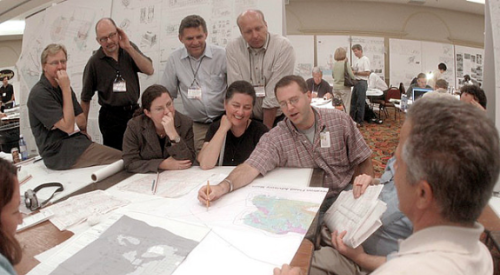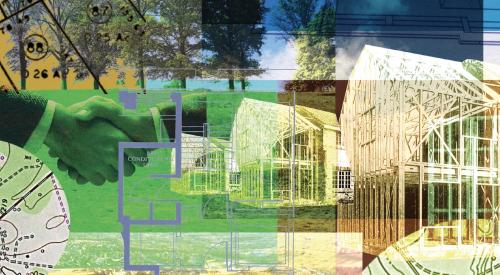| Proud partners, Carol Galante of Bridge Housing Corp. and John Brezzo of DKB Homes with their Silicon Valley affordables.
|
Touring the Milpitas, Calif., community of Summerfield, a mostly first-move-up project built by San Jose-based DKB Homes, one is struck by how All-American it looks and feels. Each of the 114 homes has two stories. Most have craftsman features that carry through across a range of colors, square footages and elevations. But being in the heart of the Silicon Valley - where there is a critical need for housing at every level - Summerfield is the exception rather than the rule. That it came to be at all is a huge victory for the companies that partnered to build it and for the area it serves.
In addition to providing needed three and four-bedroom market-rate homes for between $350,000 and $400,000, the project added 22 below-market-rate (BMR) homes for prices that began at $115,000 and never got higher than $137,000. Rare commodities, these affordables homes will stay affordable for 30 years under terms dictated by the City of Milpitas.
From the time sales began in the fall of 1997 until the spring of last year, each release of the market-rate homes sold quickly, even with several price increases. Meanwhile, demand for the 22 BMR homes was as high as one might expect given astronomical home prices in the Silicon Valley. Hundreds expressed interest and dozens applied to purchase the BMR homes that eventually sold to a lucky handful whose names were picked in a lottery.
"There were some people who applied that really could have used a home in Summerfield," notes Brezzo, "but on the positive side, 22 applicants with incomes below 80% of the area’s median are now living there."
For DKB, all of this came at a time when competition among builders for land was at an all-time high. Then as now, even well capitalized home builders are finding it difficult to acquire land and get approvals within cities that form the "inner" Bay Area, says Brezzo. Which is why Summerfield, better than most other affordable projects, highlights the success enjoyed by small and mid-sized builders like DKB that pursue infill projects with affordable elements.
Partners in Profit
Of all the ways to finance affordable, for-sale housing - down payment assistance through local government funds, silent second mortgages, grant money to reduce the cost of construction, to name a few - reducing land costs remains the surest way of making an affordable project pencil out. This was the case with Summerfield. A favorable land deal put in place by local non-profit builder Bridge Housing Corp. was key.
The story of Summerfield began in 1994 when Bridge was selected by the City of Milpitas to help it identify property on which to build a rental apartment complex with a large component of affordable units. This project would eventually become the Montevista Apartments. It was Bridge’s job to acquire the necessary land, build and manage the rentals, and put the financing in place to make the entire project happen - a typical role for non-profit partners.
According to Bridge president and CEO Carol Galante, a parcel of land owned by the County of Santa Clara was chosen for its proximity to a freeway and a shopping mall. Soon after the first piece of land was identified, another nearby site, also owned by the county, came to light. The idea, says Galante, then became to package both parcels together with the intention of bringing in a for-sale home builder, DKB, to buy the second parcel for building a mix of affordable and market-rate homes.
A critical factor working in favor of Bridge and DKB was the fact that both parcels were owned by the county. First, the county had a strong interest in developing more affordable housing. And second, California law allows public land to be sold to municipalities or non-profit entities for its appraised fair market value, avoiding open bidding. From Galante’s standpoint, the support and participation of the County of Santa Clara and Milpitas was a huge benefit.
"The combination of having two public entities involved from the beginning laid the foundation of our ability to bring a significant level of affordability to the developments," notes Galante. More important than the low land price, she says, were the favorable terms under which the county allowed the land to be sold.
For the 15.6-acre property where Bridge built the 306-unit Montevista Apartments, the county allowed one down payment and annual payments afterwards. On the 18.02-acre site where DKB built Summerfield, the county significantly reduced land carrying costs by allowing the property to be purchased in three stages - coinciding with Summerfield’s stages of sales and build out. Because DKB would have been hard-pressed to negotiate these terms on its own, Bridge was able to strike a profit-sharing agreement with DKB. The agreement, says Brezzo, established a level of expected profitability for DKB, above which Bridge would receive about 20% of the remainder.
DKB went into the project knowing it would lose money on the 22 BMR homes, the goal was to keep those losses at a minimum. Hard costs per square foot averaged $59 for the BMR homes, which averaged 1352 square feet. This meant a commitment of $81,000 per home excluding the cost of 3000 square foot lots.
Less tangible costs included the time and effort it took to win the support of the existing neighboring community. Opposition to the project began to melt away with each community meeting, he says, as three facts became known: good design, above average square footages and a plan that called for BMR homes to be mixed with market-rate homes.
DKB also played a large role in the process to select buyers of the BMR homes. The City of Milpitas advertised the availability of the homes, set up a dedicated interested-buyer hotline and hosted workshops to provide information and determine if callers were eligible to apply for the homes. DKB staff attended those workshops and coordinated the qualification of applicants through a specialty mortgage-lending group. From there Bridge, DKB and Milpitas officials jointly held lotteries giving first priority to Milpitas residents, second priority to those who work in Milpitas and third priority to all others. According to city planning office employee Gloria Anaya, nearly all of the homes went to Milpitas residents. None of the applicants in the third group were even put in the final lottery.
Due to an escalation in real estate prices during the sales and build out of Summerfield, it turns out that Bridge and DKB were well-compensated for their efforts, says Brezzo. "When we started out, it looked like a fair project. But because of the appreciation in the market it was a very profitable project for us."
For Bridge the projects were a home run all the way around. They delivered "significant" levels and numbers of affordable units, notes Galante, all while earning a return on Summerfield. Over half the 306 units in Montevista were rented to people with incomes below 60% of the area median.
Sidebars












